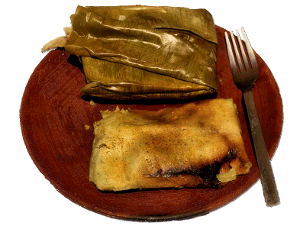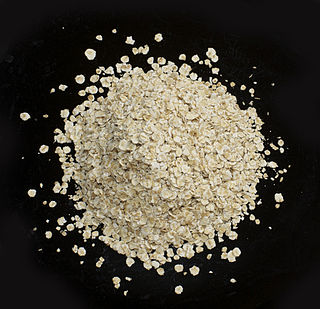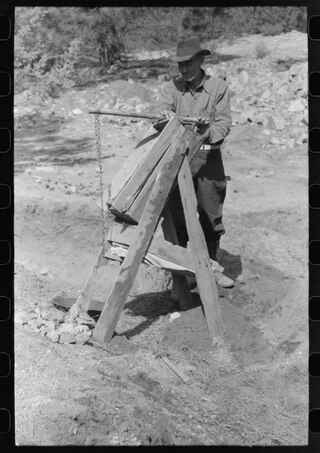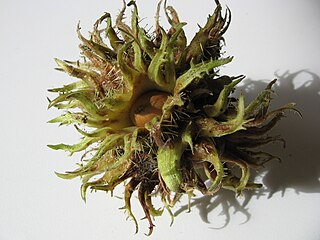
A winnowing basket or fan is a tool for winnowing grain from chaff while removing dirt and dust too. [1] They have been used traditionally in a number of civilizations for centuries, [2] and are still in use today in some countries.

A winnowing basket or fan is a tool for winnowing grain from chaff while removing dirt and dust too. [1] They have been used traditionally in a number of civilizations for centuries, [2] and are still in use today in some countries.
Unprocessed grain, mixed with impurities like dirt or inedible husks, is placed on the basket. The basket is then lifted and shaken, which separates out lighter particles (usually inedible husks) from heavier particles (the grain). The process can benefit from mild wind, which can carry away lighter particles. [1] [3]
These have been used in India from centuries and still see widespread contemporary use. They are known as soup in Hindi and dala in Bangla. In West Bengal, Odisha, Assam, and Bihar the tool is also used to welcome the groom during marriage ceremonies.[ citation needed ]

These are known as k'i (Korean : 키; Hanja : 簸) in Korea, and were used throughout the region for centuries. There was some regional variation in what materials the k'i were constructed from, with southern regions using primarily bamboo instead of wicker. [1]
There is a folk tradition where children who are unable to adequately control when they urinate (particularly while sleeping) are made to wear the k'i on their head, then sent to knock on the doors of their neighbors and ask for salt. [1] This served to publicly embarrass the child into compliance, as neighbors would recognize why the child was knocking on their door. [7] [1] [8]
In South Gyeongsang Province, there was a tradition where people avoided buying the baskets on the first market day of each lunar year, as the baskets, as they would with husks, would allow good luck to escape. [1] A tradition on Jeju Island involved a type of divination, where on Lunar New Year's Eve, the baskets would be cleaned, washed, and placed facedown. [1] The following morning, the baskets would be inspected. If rice was present under the basket, then the harvest would be good that year. [1]

Korean cuisine has evolved through centuries of social and political change. Originating from ancient agricultural and nomadic traditions in Korea and southern Manchuria, Korean cuisine reflects a complex interaction of the natural environment and different cultural trends.

A tamale, in Spanish tamal, is a traditional Mesoamerican dish made of masa, a dough made from nixtamalized corn, which is steamed in a corn husk or banana leaves. The wrapping can either be discarded prior to eating or used as a plate. Tamales can be filled with meats, cheeses, fruits, vegetables, herbs, chilies, or any preparation according to taste, and both the filling and the cooking liquid may be seasoned.

Dhumavati is one of the Mahavidyas, a group of ten Hindu Tantric goddesses. Dhumavati represents the fearsome aspect of Mahadevi, the supreme goddess in Hindu traditions such as Shaktism. She is often portrayed as an old, ugly widow, and is associated with things considered inauspicious and unattractive in Hinduism, such as the crow and the chaturmasya period. The goddess is often depicted carrying a winnowing basket on a horseless chariot or riding a crow, usually in a cremation ground.

Winnowing is a process by which chaff is separated from grain. It can also be used to remove pests from stored grain. Winnowing usually follows threshing in grain preparation. In its simplest form, it involves throwing the mixture into the air so that the wind blows away the lighter chaff, while the heavier grains fall back down for recovery. Techniques included using a winnowing fan or using a tool on a pile of harvested grain.

Oatmeal is a preparation of oats that have been de-husked, steamed, and flattened, or a coarse flour of hulled oat grains (groats) that have either been milled (ground), rolled, or steel-cut. Ground oats are also called white oats. Steel-cut oats are known as coarse oatmeal, Irish oatmeal, or pinhead oats. Rolled oats were traditionally thick old-fashioned oats, but can be made thinner or smaller, and may be categorized as quick oatmeal or instant oatmeal depending on the cooking time required, which is determined by the size of the oats and the amount of precooking.

Wood carving is a form of woodworking by means of a cutting tool (knife) in one hand or a chisel by two hands or with one hand on a chisel and one hand on a mallet, resulting in a wooden figure or figurine, or in the sculptural ornamentation of a wooden object. The phrase may also refer to the finished product, from individual sculptures to hand-worked mouldings composing part of a tracery.

Chaff is dry, scale-like plant material such as the protective seed casings of cereal grains, the scale-like parts of flowers, or finely chopped straw. Chaff cannot be digested by humans, but it may be fed to livestock, ploughed into soil, or burned.

A mortar and pestle is a set of two simple tools used to prepare ingredients or substances by crushing and grinding them into a fine paste or powder in the kitchen, laboratory, and pharmacy. The mortar is characteristically a bowl, typically made of hardwood, metal, ceramic, or hard stone such as granite. The pestle is a blunt, club-shaped object. The substance to be ground, which may be wet or dry, is placed in the mortar where the pestle is pounded, pressed, or rotated into the substance until the desired texture is achieved.

Threshing, or thrashing, is the process of loosening the edible part of grain from the straw to which it is attached. It is the step in grain preparation after reaping. Threshing does not remove the bran from the grain.

Matthew 3:12 is the twelfth verse of the third chapter of the Gospel of Matthew in the New Testament. The verse occurs in the section relating the preachings of John the Baptist. In this he uses the imagery of harvesting wheat to describe God's judgement.

Rice hulls or husks are the hard protecting coverings of grains of rice. In addition to protecting rice during the growing season, rice hulls can be put to use as building material, fertilizer, insulation material, or fuel. Rice hulls are part of the chaff of the rice.

A flail is an agricultural tool used for threshing, the process of separating grains from their husks.

Tteok is a class of Korean rice cakes made with steamed flour made of various grains, including glutinous or non-glutinous rice. Steamed flour can also be pounded, shaped, or pan-fried to make tteok. In some cases, tteok is pounded from cooked grains.

A drywasher is a common desert mining tool for gold mining.

Lunar soil is the fine fraction of lunar regolith found on the surface of the Moon and contributes to the Moon's tenuous atmosphere. Lunar soil differs in its origin and properties significantly from terrestrial soil.

A threshing stone is a roller-like tool used for the threshing of wheat. Similar to the use of threshing boards, the stone was pulled by horses over a circular pile of harvested wheat on a hardened dirt surface, and the rolling stone knocked the grain from the head of wheat. The straw was removed from the pile and the remaining grain and chaff was collected. By a process called winnowing, the grain was tossed into the air to allow the chaff and dirt to be blown away, leaving only the grain.
The Tiangong Kaiwu (天工開物), or The Exploitation of the Works of Nature was a Chinese encyclopedia compiled by Song Yingxing. It was published in May 1637 with funding provided by Song's patron Tu Shaokui. The Tiangong Kaiwu is an encyclopedia covering a wide range of technical issues, including the use of various gunpowder weapons. Copies of the book were very scarce in China during the Qing dynasty (1644–1911), but original copies of the book were preserved in Japan.
Stripper was a type of harvesting machine common in Australia in the late 19th and early 20th century. John Ridley is now accepted as its inventor, though John Wrathall Bull argued strongly for the credit.

Husk in botany is the outer shell or coating of a seed. In the United States, the term husk often refers to the leafy outer covering of an ear of maize (corn) as it grows on the plant. Literally, a husk or hull includes the protective outer covering of a seed, fruit, or vegetable.

Fengshanche was a winnowing machine that was used in ancient China to separate the grain from the chaff or seed casings after harvest. The winnowing machine also had a rotary fan which had a blower that had a crank handle to create air to blow away the lighter seed casings to separate the husks from the pile of grain.